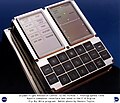Fichier:Apollo display and keyboard unit (DSKY) used on F-8 DFBW DVIDS683588.jpg

Taille de cet aperçu : 765 × 600 pixels. Autres résolutions : 306 × 240 pixels | 612 × 480 pixels | 980 × 768 pixels | 1 280 × 1 004 pixels | 2 560 × 2 007 pixels | 3 030 × 2 376 pixels.
Fichier d’origine (3 030 × 2 376 pixels, taille du fichier : 6,18 Mio, type MIME : image/jpeg)
Historique du fichier
Cliquer sur une date et heure pour voir le fichier tel qu'il était à ce moment-là.
| Date et heure | Vignette | Dimensions | Utilisateur | Commentaire | |
|---|---|---|---|---|---|
| actuel | 9 octobre 2021 à 08:29 |  | 3 030 × 2 376 (6,18 Mio) | Huntster | Cropped 9 % vertically using CropTool with lossless mode. |
| 9 octobre 2021 à 08:28 |  | 3 030 × 2 606 (5,97 Mio) | Huntster | Full resolution from NASA. | |
| 6 mai 2015 à 02:42 |  | 1 536 × 1 321 (303 kio) | Fæ | == {{int:filedesc}} == {{milim | description = {{en|1=The display and keyboard (DSKY) unit used on the F-8 Digital Fly-By-Wire (DFBW) aircraft during Phase I of the fly-by-wire program. Warning lights are in the upper left section, displays in the uppe... |
Utilisation du fichier
Les 2 pages suivantes utilisent ce fichier :
Usage global du fichier
Les autres wikis suivants utilisent ce fichier :
- Utilisation sur ar.wikipedia.org
- Utilisation sur en.wikipedia.org
- Utilisation sur es.wikipedia.org
- Utilisation sur fi.wikipedia.org
- Utilisation sur he.wikipedia.org
- Utilisation sur hu.wikipedia.org
- Utilisation sur ja.wikipedia.org
- Utilisation sur pl.wikipedia.org
- Utilisation sur ru.wikipedia.org
- Utilisation sur uk.wikipedia.org

